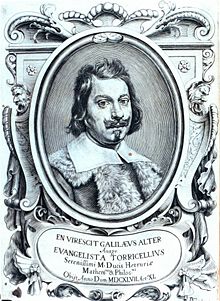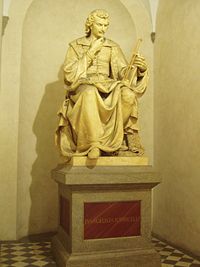Evangelista Torricelli
<<This article is rather short. Please flesh it out. Also add a "Legacy" section that summarizes his main accomplishments and the influence of his work on society at large.>>
Evangelista Torricelli (October 15, 1608 – October 25, 1647) was an Italian physicist and mathematician, best known for his invention of the barometer. In addition he was a pioneer in the study of the motion of fluids and is regarded by some (noteably Ernst Mach)as the "father of hydrodynamics". His contributions to science include: a theory describing the relationship between temperature, air density and wind; mathematical equations describing the rotations of curves and solids which led to the development of calculus; and a physical eveidence and philosophical arguments proving the existence of a vacuum. His assertion of the occurance of a vacuum in nature contradicted the Aristotelian view held by authorities of his time.
Biography
Torricelli was born in Faenza [[Papal States], near Ravenna, Italy. He was left fatherless at an early age and educated under the care of his uncle, a Camaldolese monk, who first entered young Torricelli in a Jesuit College in 1624 to study mathematics and philosophy until 1626, when he sent Toricelli to Rome in 1627 to study science under the Benedictine Benedetto Castelli, professor of mathematics at the Collegio della Sapienza in Pisa.
In 1632, shortly after the publication of Galileo's Dialogue concerning the Two Chief World Systems, Torricelli wrote to Galileo of reading it "with the delight [...] of one who, having already practised all of geometry most diligently [...] and having studied Ptolemy and seen almost everything of Tycho [Brahe], Kepler and Longomontanus, finally, forced by the many congruences, came to adhere to Copernicus, and was a Galileian in profession and sect." (The Vatican condemned Galileo in June 1633, and this was the only known occasion on which Torricelli openly declared himself to hold the Copernican view.)
Aside from several letters, little is known of Torricelli's activities in the years between 1632 and 1641, when Castelli sent Torricelli's monograph of the path of projectiles to Galileo, then a prisoner in his villa at Arcetri. Although Galileo promptly invited Torricelli to visit, he did not accept until just three months before Galileo's death. During his stay, however, he wrote out Galileo's Discourse of the Fifth day. After Galileo's death on January 8, 1642, Grand Duke Ferdinando II de' Medici asked him to succeed Galileo as the grand-ducal mathematician and professor of mathematics in the University of Pisa. In this role he solved some of the great mathematical problems of the day, such as finding a cycloid's area and center of gravity. He also designed and built a number of telescopes and simple microscopes; several large lenses, engraved with his name, are still preserved at Florence. In 1644, he famously wrote in a letter: "We live submerged at the bottom of an ocean of air."
Torricelli died in Florence a few days after having contracted typhoid fever, and was buried in San Lorenzo. The asteroid (7437) Torricelli was named in his honor.
Contributions to physics
Torricelli's chief invention was the barometer, which arose from solving an important practical problem. Pumpmakers of the Grand Duke of Tuscany attempted to raise water to a height of 12 meters or more, but found that 10 meters was the limit to which it would rise in the suction pump. Torricelli thought to employ mercury, fourteen times as heavy as water. In 1643 he created a tube c. 1 meters long, sealed at the top end, filled it with mercury, and set it vertically into a basin of mercury. The column of mercury fell to about 70cm, leaving a Torricellian vacuum above. As we now know, the column's height fluctuated with changing atmospheric pressure; this was the first barometer. This discovery has perpetuated his fame, and the torr, a unit of pressure, was named in his honor.
Torricelli also discovered Torricelli's Law, regarding the speed of a fluid flowing out of an opening, which was later shown to be a particular case of Bernoulli's principle.
Selected works
His manuscripts are preserved at Florence, Italy. The following have appeared in print:
- Trattato del moto, Florence, before 1641
- Opera geometrica, Florence, 1644
- Lezioni accademiche, Florence, printed 1715
- Esperienza dell'argento vivo, reprint, Berlin, 1897
See also
- Torricelli's equation
- Torricelli's Law
- Fermat point
- Gabriel's horn
ReferencesISBN links support NWE through referral fees
<<We need at least 3 reliable references here, formatted according to our guidelines.>>
- Weil, André, Prehistory of the Zeta-Function, in Number Theory, Trace Formulas and Discrete Groups, Aubert, Bombieri and Goldfeld, eds., Academic Press, 1989
- de Gandt, l'oeuvre de Torricelli, Les Belles Lettres, 1987
External links
Credits
New World Encyclopedia writers and editors rewrote and completed the Wikipedia article in accordance with New World Encyclopedia standards. This article abides by terms of the Creative Commons CC-by-sa 3.0 License (CC-by-sa), which may be used and disseminated with proper attribution. Credit is due under the terms of this license that can reference both the New World Encyclopedia contributors and the selfless volunteer contributors of the Wikimedia Foundation. To cite this article click here for a list of acceptable citing formats.The history of earlier contributions by wikipedians is accessible to researchers here:
The history of this article since it was imported to New World Encyclopedia:
Note: Some restrictions may apply to use of individual images which are separately licensed.

